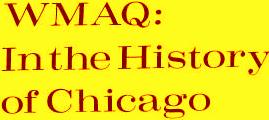A Guided Tour of WMAQ-TV

See
the State-of-the-Art Television Facilities as They Appeared in 1970
| CURATOR'S
NOTE: The text and pictures below are from the article
"WMAQ in the History of Chicago" that appeared in the
March/April, 1970 edition of Broadcast Journal magazine.
The author, Chet Campbell, was then director of WMQ-TV's public
information department. In 1970, WMAQ-TV was well into the period
of expansion that lasted until General Electric's 1985 acquisition
of RCA. Read Chet's introduction below. The chose the areas you
would like to visit from the links that follow. |
| Chicago's huge
Merchandise Mart, a two-block square landmark overlooking the North Branch of
the Chicago River, occupies a place in broadcasting history. Since 1931, it has
been the home of NBC's Midwest operations---the pioneer WMAQ radio, the second
oldest AM station in Chicago, since 1948 WMAQ television. WMAQ radio is credited
with a number of "firsts" which include such pioneer efforts as the
University of Chicago Roundtable, radio's first daytime serial, Lights
Out; the first broadcast of intercollegiate baseball and football; the
first overseas news report and launching such talent as Fibber
McGee and Molly, Amos and Andy,
Gary Moore, Mercedes McCambridge and Red Skelton. WMAQ-TV followed in the same
pattern as its sister radio station, having been the incubator of the "Chicago
School" of informal television production techniques in the 1950s. WMAQ-TV
has also contributed to its share of innovative programming---Garroway
at Large, Zoo Parade,
Ding Dong Schooll and Kukla,
Fran and Ollie. |
World's
First All-Color Station
| Sunday,
April 15th, 1956, was a milestone for both WMAQ-TV (then WNBQ)
and the television industry. It was "C-Day", described
by Broadcasting-Telecasting Magazine as "a daring break through
the black and white curtain," and the date WMAQ-TV became
the world's first all-color television station. Brig. General
David Sarnoff, then chairman of the board of RCA and NBC, first
announced the conversion of WMAQ-TV to all-color six months earlier
in an historical closed circuit news conference from both New
York and Chicago. The station installed its first color equipment
in 1953 and the first major network color transmission was the
Rose Bowl parade in 1954. In April, 1956, when WMAQ-TV began telecasting
all local live programs in color, there were an estimated 50,000
color sets in the Chicago market. Today there are more than a
million color sets in the market. Today WMAQ-TV airs more than
17 hours of local news programming each week. It is the only Chicago
station with its own color film processor; with news crews on
the street 24 hours a day; with videotape mobile units assigned
to news coverage and has the only outside the city news bureau---the
Northwest Indiana Bureau, staffed with a reporter and a film cres
in Gary, Ind. NBC Chicago has a news operation of about 130 persons,
which serves both WMAQ Television and Radio, and the NBC radio
and television networks. On the network level, the NBC Chicago
news operation covers the entire Midwest and parts of the South,
and includes a separate Huntley-Brinkley unit. The Chicago office
provides an average of 180 news feeds to the NBC-TV network each
month. WMAQ-TV's production and technical facilities are housed
on the 19th and 20th floors of the Merchandise Mart, in the studio
and office areas which were incorporated into the original plan
of the buildings of the building when it was built in the early
1930's. Constant remodeling and renovation of studios, control
rooms and other technical areas, have kept pace with technological
developments in the industry. Studios which once were originating
such radio programs as the Carnation Contented Hour and
First Nighter
are now the most modern and efficient television production centers
in the Midwest. The NBC Chicago operation now is expanding into
an additional 33.000 square feet of space in a building constructed
on the roof of the Merchandise Mart for Eastern Airlines several
years ago. The airline vacated the space last year and moved to
suburban Chicago. |
You
may visit the following areas:
Comments
or suggestions? click
here to send them to Rich Samuels
Created
by Rich Samuels (e-mail to rich@richsamuels.com)
|

